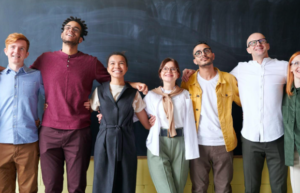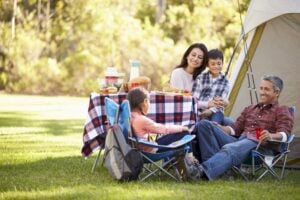Ditching assigned seatings in favor of beanbags and standing desks
Flexible learning spaces been the buzzwords of industry for many years now and it appears this concept has developed from a ‘nice idea’ to the current directional norm. Riding the momentum of laidback start-ups, companies and schools across the world are reinventing their spaces to try to engage employees and students in new and comfortable ways.
Traditionally, a classroom has a central focus in the form of a whiteboard with all furniture facing in the direction of this knowledge source. Students are seated in various arrangements including rows, columns or, in some cases, groups. This model has proven effective for generations and students have sat quietly and accepted the teacher’s word as truth, so why then do we need to challenge this archetypal classroom?
Classrooms are starting to look more like coffee shops with the traditional central focus being replaced with smaller meeting groups and spaces. One large whiteboard has become multiple smaller boards dispersed around the room and tables have been raised and lowered to create variation. A teacher’s goal of achieving a perfect classroom of matching tables and chairs has changed to a celebration of variation as students find comfort on couches, bean bags, sit/stand desks, pillows and deck chairs. Tables and walls are being painted with whiteboard paint and square classes are being divided into smaller meeting areas where students can recline and interact with each other
With all this change from the traditional rule, school leadership is now faced with the decision of integration of this new classroom design. Is this way of learning here to stay and worthy of a large investment or would small changes to the classroom suffice as we await the next classroom vogue?
Before any change is ever considered, schools must consider the implications for those who matter most: our students. How is a change in furniture going to support student engagement and learning?
Through the Spaces Research Project, Kariippanon et al. (2016) discovered that the primary driving force behind the changes made in schools was the recognition of the need to adapt pedagogical approaches to better meet the needs of 21st century learners. Executives and teachers spoke of moving away from didactic teaching and embracing student-centred learning, collaboration, peer teaching and self-regulation to improve students’ engagement, motivation and learning outcomes. It is important for schools to understand that a colourful, flexible learning space does not equate to better learning. If changing the furniture is the school’s only answer to meeting students’ needs, it will find itself with nothing more than an attractive and expensive mirage. So how can teachers form flexible learning spaces within their own classrooms? No matter what the budget, adjustments can be made to cater for 21st century learning. Below are some suggestions for how to create flexible learning spaces in your school.
Shoeless Learning
Shoeless learning spaces are becoming more common throughout the world due to the significant links to concentration levels and behavior; however, it is still unknown why this works. In China, it is believed to have links to reflexology, in India being shoeless is linked to respect and in Western countries to feeling more like home. Whatever the answer, classes and schools around the world are reaping the benefits of going shoeless both in individual classes and as whole schools.
Write-on Surfaces
Another trend within classes that is going viral is the write-on surface. This is another simple and affordable modification that can be implemented in any classroom to assist students’ learning. Being able to write on surfaces is not just about convenience for children, instead it gives them a sense of audience and purpose. Their work is available to the whole group or class and is visible for everybody that enters the room. While writing in books is private, writing on a surface in full view of everybody adds to classroom conversation and allows everyone to become more aware of each other’s work. This adjustment can be through purposebuilt furniture or by painting your current walls and desktops with write-on paint. Windows and whiteboards scattered around the room are also useful for small group work or for students to write their ideas over. While whiteboards are fluid workspaces with work constantly being erased, students and teachers can take photos to keep records of their work on their digital devices.
Indoor plants
Another simple adjustment is to introduce indoor plants into the learning space. Plants provide many benefits to learning spaces besides their visual appeal. Students have noted that plants provide a calming atmosphere and make the classroom feel more like home. In a space that can often feel clinical and generic, plants add a softer touch and a tangible, textural change from the usual flat and shiny surfaces. Indoor plants also work hard to purify the air within your workspace by providing more oxygen, removing toxins from the air and releasing moisture through photosynthesis. Plants have also been linked to increasing focus and relieving stress.

Standing Desks
Humans are not made to sit for extended periods. For decades, research has been telling us that being sedentary for long periods of time is detrimental to our health both physically and mentally. This is especially true for children who are naturally active and wanting to move. It has even been discovered that students who are living a sedentary lifestyle may experience poor academic achievement and low self-esteem. Providing tables that allow students to stand increases students’ movement and interaction. Standing desks that are purpose-built can also be moved and adjusted easily to suit a range of different heights. Not all students enjoy standing all day, so providing a group of standing and sitting desks provides students with options to change as needed.

Alternative Seating
Along with standing desks, students also like to change seating styles. Classes have adopted a range of different seating styles to allow flexibility and diversity in where and how students work. Couches, beanbags and rugs have encouraged students to get down on the floor and into more comfortable positions and to create different learning environments that replicate a café-style setting. While sitting in a beanbag is not going to be ideal for neat handwriting, it mayprovide a change in atmosphere for a student to sit with a laptop or for group conversation. Flexible seating options that can be easily moved allow for better collaboration and can vary with different group sizes.
Wall Displays And Color
As a teacher fresh out of university, my first impression of classrooms was that there was a correlation between the number of displays and the quality of teaching. Rooms were filled with posters upon posters and art hanging from every surface of the room. Not only were posters rarely ever referenced, they were overstimulating and claustrophobic. Many teachers are now opting for the ‘bare walls’ approach, choosing instead to paint walls in a pleasant color that encourages creativity and comfort. The key to creating an environment that promotes learning is to ensure classes are not overstimulating. Overstimulation is usually caused by large displays in bright colours, especially reds and oranges. Conversely, colors such as green and blue promote a calming, relaxed and creative environment. A simple way of adding color to a room is to add pillows, pots or furniture in chosen colors.
Flexible learning spaces work because teachers and schools have adapted their approaches to meet the needs of 21st century students. They have adapted their lesson structure, changed their methods of assessing, accepted appropriate technology and ultimately allowed noise all in the pursuit of creating an environment that will support and nurture a generation of students that require a different education.
In a world that requires adaptation, flexible learning spaces are here to stay and will continue to evolve as research reveals the benefits of collaboration and projectbased learning. Schools that elect against this movement, I fear, will be left in the back room beside the overhead projector and dusty textbooks.




